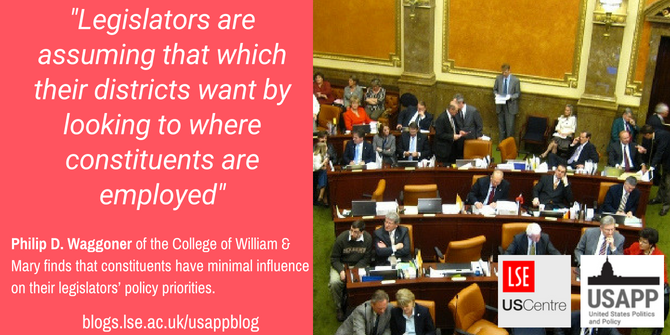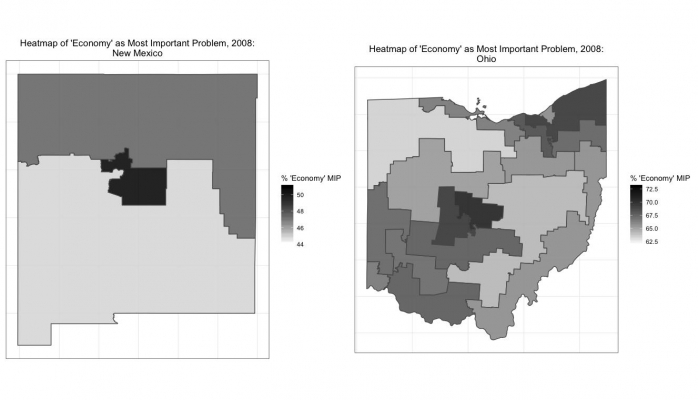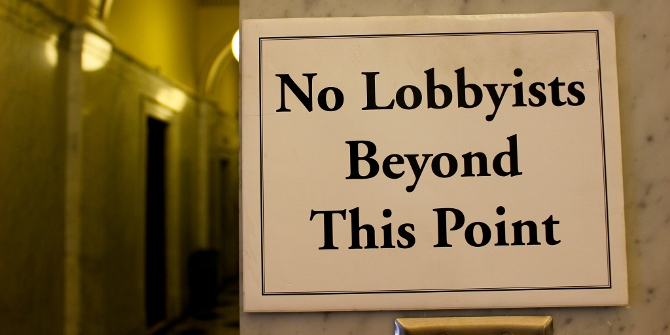 The most basic function of elected politicians is to represent the priorities of their constituents. But to what extent do legislators’ policy priorities actually reflect what people want? In new research, Philip D. Waggoner uses states’ industrial patterns in combination with survey research to model constituents’ preferences and then places these against legislators’ bill sponsorship. He finds that legislators tend to make assumptions about what their constituents want, based on the industries in their state, rather than on their expressed policy priorities.
The most basic function of elected politicians is to represent the priorities of their constituents. But to what extent do legislators’ policy priorities actually reflect what people want? In new research, Philip D. Waggoner uses states’ industrial patterns in combination with survey research to model constituents’ preferences and then places these against legislators’ bill sponsorship. He finds that legislators tend to make assumptions about what their constituents want, based on the industries in their state, rather than on their expressed policy priorities.
Academics, policymakers, and citizens have long searched for an answer to the questions of whether and to what extent electors are influencing the elected. These questions strike at the heart of the representative democratic system that characterizes American politics and policymaking. While evidence exists on both sides, with some suggesting constituents do influence legislators and other suggesting they do not, another question remains: do constituents influence the policy priorities of their members of Congress? In recent research, I suggest the answer is, probably not too much.
To begin to understand whether legislators are responsive to the preferences of their constituents, we need to measure constituents’ preferences (the “call”) and then legislators’ policy focus (the “response”). Though there are many ways to approach these measures, beginning with constituent preferences, I take two approaches in an effort to be as exhaustive in this quest for policy responsiveness as possible. First, I use patterns of employment in specific industries in the districts to serve as proxies for preferences. The key assumption with this measure is that the industries in which constituents work should translate to policy preferences related to that industry (e.g., agriculture workers should prefer agriculture policy, or defense contractors should prefer defense-related policy from their legislators). Though limited in certain respects, the relatively frequent use of such a measure in the academic literature suggests it should at least provide a starting point in a search for policy responsiveness.
Then, for the second measure of preferences, I develop a new, more direct measure based on constituents’ selections of issues in response to the oft-asked “most important problem” (MIP) question. The measure leverages responses from every wave of the Cooperative Congressional Election Study (CCES) the MIP question was asked. The key benefit of this more direct approach is that it allows respondents to place themselves in “issue policy space” by selecting a given issue over several others when presented with many options. The measure, calculated at the district level and inferring nothing of latent ideology, provides a more direct look at precisely that which constituents highlight as the most important problems from their perspectives. The result, then, is a measure of constituents’ preferences across numerous issues, which should be of highest priority to their respective legislators, if the delegate model of representation serves as a useful guide. Whether legislators positively respond to these preferences is the purpose of my study.

“Legislature” by Mike Renlund is licensed under CC BY NC SA
Before launching into the analysis and findings, Figure 1 offers a visual look at the distribution of the direct measure. Figure 1 shows the percentage of constituents in Ohio’s and New Mexico’s Congressional districts that selected the “economy” as the most important problem in 2008, which was the beginning of the Great Recession. Note that Midwest and northeast states were hit hardest by the Great Recession, while southwestern and border states were hit much less hard by comparison. And further, in larger metropolitan areas with greater concentrations of residents and businesses, the effects of an economic downturn are felt most intensely. Seen in these two state examples, my measure picks up these trends showing first, greater selection of “economy” as the most important problem in Ohio overall (Midwest) compared to New Mexico (border state), and then in the metropolitan areas of each state, depicted by darker shades.
Figure 1 – District Heatmaps of Selecting “Economy” as the Most Important Problem in 2008

With the two constituent preference measures in hand, I look to bill sponsorship as my key measure of elite policy work to address the other side of the equation. This form of behavior was selected over other forms (e.g., roll call voting or district casework), as it is among the most consistently and widely engaged in forms of policy representation in the US House of Representatives. Thus, it is helpful in our quest for responsiveness in that it allows for an understanding of whether legislators are influenced by their constituents as they focus on a given issue over many others as they decide to sponsor individual bills on individual topics.
In sum, the first stage of my analysis pairs employment patterns with bill sponsorship on related issues to look for responsiveness, and the second phase pairs the direct measure of preferences with bill sponsorship on related issues to look for policy responsiveness.
For the first stage looking to proxies, I uncovered some evidence of employment patterns influencing increased bill sponsorship attention on related issues. In districts with higher levels of employment in agriculture, defense, and transportation, rates of related bill sponsorship were similarly and significantly higher, compared to other districts with lower rates of employment in these industries.
Though seemingly optimistic at the first stage, the second stage, which looked at direct and overtly stated issue preferences, revealed no consistent impacts on legislators’ sponsorship attention. Across numerous issues, such as defense, the environment, healthcare, education, and others, legislators are not responding to the calls of constituents to focus sponsorship attention on these issues.
As the few patterns of responsiveness uncovered were a function of industry-specific employment and not constituents’ stated issue preferences, this suggests that legislators are assuming that which their districts want by looking to where constituents are employed. However, when it comes to that which constituents actually express as top policy priorities, legislators seem uninterested, or at best, unaware.
- This article is based on the paper, ‘Do Constituents Influence Issue-Specific Bill Sponsorship?’ in American Politics Research.
Please read our comments policy before commenting
Note: This article gives the views of the author, and not the position of USAPP– American Politics and Policy, nor of the London School of Economics.
Shortened URL for this post: http://bit.ly/2uihZHR
About the author
 Philip D. Waggoner – College of William & Mary
Philip D. Waggoner – College of William & Mary
Philip D. Waggoner is a Visiting Assistant Professor in the Department of Government at the College of William & Mary. His research and teaching interests include representation, public policy, quantitative methods, and applied and computational statistics. His work has been supported by the Office of the Director of National Intelligence (ODNI), the Intelligence Advanced Research Projects Activity (IARPA), the Institute for Humane Studies, the William A. Steiger Fund for Legislative Studies and the Centennial Center of the American Political Science Association. His work appears in Political Research Quarterly, American Politics Research, and Research & Politics, among other outlets. For more, feel free to visit, http://www.philipdwaggoner.com/ or follow him on Twitter @philipdwaggoner.







Well duh. They’re responsive to their constituents who have money. And non constituents who have money. We have a Donorate and an Electorate, and the Donorate is primary.